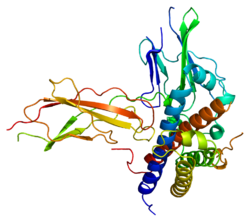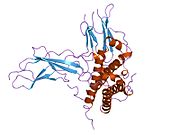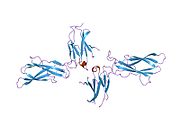Growth hormone receptor: Difference between revisions
Adding reference for the GHR protein alignment. |
No edit summary |
||
| Line 5: | Line 5: | ||
{{PBB_Summary |
{{PBB_Summary |
||
| section_title = |
| section_title = |
||
| summary_text = This gene encodes a protein that is a transmembrane receptor for [[growth hormone]]. Binding of growth hormone to the receptor leads to receptor [[Dimer (chemistry)|dimerization]] (the receptor may however also exist as |
| summary_text = This gene encodes a protein that is a transmembrane receptor for [[growth hormone]]. Binding of growth hormone to the receptor leads to reorientation of a pre-assembled receptor dimer [[Dimer (chemistry)|dimerization]] (the receptor may however also exist as as monomers on the cell surface <ref>Gonzalez, L., L. M. Curto, et al. (2007). "Differential regulation of membrane associated-growth hormone binding protein (MA-GHBP) and growth hormone receptor (GHR) expression by growth hormone (GH) in mouse liver." Growth Horm IGF Res 17(2): 104-112.</ref>) and the activation of an intra- and intercellular signal transduction pathway leading to growth <ref>{{cite journal|last1=Brooks|first1=Andrew J.|last2=Dai|first2=Wei|last3=O’Mara|first3=Megan L.|last4=Abankwa|first4=Daniel|last5=Chhabra|first5=Yash|last6=Pelekanos|first6=Rebecca A.|last7=Gardon|first7=Olivier|last8=Tunny|first8=Kathryn A.|last9=Blucher|first9=Kristopher M.|last10=Morton|first10=Craig J.|last11=Parker|first11=Michael W.|last12=Sierecki|first12=Emma|last13=Gambin|first13=Yann|last14=Gomez|first14=Guillermo A.|last15=Alexandrov|first15=Kirill|last16=Wilson|first16=Ian A.|last17=Doxastakis|first17=Manolis|last18=Mark|first18=Alan E.|last19=Waters|first19=Michael J.|title=Mechanism of Activation of Protein Kinase JAK2 by the Growth Hormone Receptor|journal=Science|date=16 May 2014|volume=344|issue=6185|pages=1249783|doi=10.1126/science.1249783|url=http://science.sciencemag.org/content/344/6185/1249783.full|language=en|issn=0036-8075}}</ref>. A common alternate allele of this gene, called GHRd3, lacks exon three and has been well-characterized. Mutations in this gene have been associated with [[Laron syndrome]], also known as the growth hormone insensitivity syndrome (GHIS), a disorder characterized by short stature (proportional dwarfism). Other splice variants, including one encoding a soluble form of the protein (GHRtr), have been observed but have not been thoroughly characterized.<ref name="entrez"/> Laron mice (that is mice genetically engineered to carry defective Ghr), have a dramatic reduction in body mass (only reaching 50% of the weight of normal siblings), and also show a ~40% increase in lifespan. |
||
}} |
}} |
||
[[File:Euryzygomatomyinae GHR AA.svg|thumb|right|Conserved and variable positions of the GHR protein are evidenced by multiple amino acid sequence comparisons among rodents. The site in yellow emphasizes a [[Proline]] shared by all species in blue and represents a protein signature of their common ancestry.<ref name="Fabre2017"/>]] |
[[File:Euryzygomatomyinae GHR AA.svg|thumb|right|Conserved and variable positions of the GHR protein are evidenced by multiple amino acid sequence comparisons among rodents. The site in yellow emphasizes a [[Proline]] shared by all species in blue and represents a protein signature of their common ancestry.<ref name="Fabre2017"/>]] |
||
Revision as of 00:46, 4 January 2018
Growth hormone receptor is a protein that in humans is encoded by the GHR gene.[5] GHR orthologs [6] have been identified in most mammals.

Interactions
Growth hormone receptor has been shown to interact with SGTA,[8] PTPN11,[9][10] Janus kinase 2,[11][12][13] Suppressor of cytokine signaling 1[14] and CISH.[14]
Evolution
The GHR gene is used in animals as a nuclear DNA phylogenetic marker.[6] The exon 10 has first been experienced to explore the phylogeny of the major groups of Rodentia.[15][16][17] GHR has also proven useful at lower taxonomic levels, e.g., in octodontoid,[18][7] arvicoline,[19] muroid,[20][21] murine,[22] and peromyscine [23] rodents, in arctoid [24] and felid [25] carnivores, and in dermopterans.[26] Note that the GHR intron 9 has also been used to investigate the mustelid [27] and hyaenid [28] carnivores phylogenetics.
Antagonists
Growth hormone receptor antagonists such as pegvisomant (trade name Somavert) are used in the treatment of acromegaly.[29] They are used if the tumor of the pituitary gland causing the acromegaly cannot be controlled with surgery or radiation, and the use of somatostatin analogues is unsuccessful. Pegvisomant is delivered as a powder that is mixed with water and injected under the skin.[30]
See also
References
- ^ a b c GRCh38: Ensembl release 89: ENSG00000112964 – Ensembl, May 2017
- ^ a b c GRCm38: Ensembl release 89: ENSMUSG00000055737 – Ensembl, May 2017
- ^ "Human PubMed Reference:". National Center for Biotechnology Information, U.S. National Library of Medicine.
- ^ "Mouse PubMed Reference:". National Center for Biotechnology Information, U.S. National Library of Medicine.
- ^ "Entrez Gene: GHR growth hormone receptor".
- ^ a b "OrthoMaM phylogenetic marker: GHR coding sequence".
- ^ a b Fabre, Pierre-Henri; Upham, Nathan S.; Emmons, Louise H.; Justy, Fabienne; Leite, Yuri L. R.; Loss, Ana Carolina; Orlando, Ludovic; Tilak, Marie-Ka; Patterson, Bruce D.; Douzery, Emmanuel J. P. (2017-03-01). "Mitogenomic Phylogeny, Diversification, and Biogeography of South American Spiny Rats". Molecular Biology and Evolution. 34 (3): 613–633. doi:10.1093/molbev/msw261. ISSN 0737-4038.
- ^ Schantl, Julia A; Roza Marcel; De Jong Ad P; Strous Ger J (August 2003). "Small glutamine-rich tetratricopeptide repeat-containing protein (SGT) interacts with the ubiquitin-dependent endocytosis (UbE) motif of the growth hormone receptor". Biochem. J. 373 (Pt 3). England: 855–63. doi:10.1042/BJ20021591. ISSN 0264-6021. PMC 1223544. PMID 12735788.
{{cite journal}}: Cite has empty unknown parameters:|laydate=,|laysource=, and|laysummary=(help) - ^ Stofega, M R; Herrington J; Billestrup N; Carter-Su C (September 2000). "Mutation of the SHP-2 binding site in growth hormone (GH) receptor prolongs GH-promoted tyrosyl phosphorylation of GH receptor, JAK2, and STAT5B". Mol. Endocrinol. 14 (9). UNITED STATES: 1338–50. doi:10.1210/me.14.9.1338. ISSN 0888-8809. PMID 10976913.
{{cite journal}}: Cite has empty unknown parameters:|laydate=,|laysource=, and|laysummary=(help) - ^ Moutoussamy, S; Renaudie F; Lago F; Kelly P A; Finidori J (June 1998). "Grb10 identified as a potential regulator of growth hormone (GH) signaling by cloning of GH receptor target proteins". J. Biol. Chem. 273 (26). UNITED STATES: 15906–12. doi:10.1074/jbc.273.26.15906. ISSN 0021-9258. PMID 9632636.
{{cite journal}}: Cite has empty unknown parameters:|laydate=,|laysource=, and|laysummary=(help)CS1 maint: unflagged free DOI (link) - ^ Frank, S J; Yi W; Zhao Y; Goldsmith J F; Gilliland G; Jiang J; Sakai I; Kraft A S (June 1995). "Regions of the JAK2 tyrosine kinase required for coupling to the growth hormone receptor". J. Biol. Chem. 270 (24). UNITED STATES: 14776–85. doi:10.1074/jbc.270.24.14776. ISSN 0021-9258. PMID 7540178.
{{cite journal}}: Cite has empty unknown parameters:|laydate=,|laysource=, and|laysummary=(help)CS1 maint: unflagged free DOI (link) - ^ VanderKuur, J A; Wang X; Zhang L; Campbell G S; Allevato G; Billestrup N; Norstedt G; Carter-Su C (August 1994). "Domains of the growth hormone receptor required for association and activation of JAK2 tyrosine kinase". J. Biol. Chem. 269 (34). UNITED STATES: 21709–17. ISSN 0021-9258. PMID 8063815.
{{cite journal}}: Cite has empty unknown parameters:|laydate=,|laysource=, and|laysummary=(help) - ^ Hellgren, G; Jansson J O; Carlsson L M; Carlsson B (June 1999). "The growth hormone receptor associates with Jak1, Jak2 and Tyk2 in human liver". Growth Horm. IGF Res. 9 (3). SCOTLAND: 212–8. doi:10.1054/ghir.1999.0111. ISSN 1096-6374. PMID 10502458.
{{cite journal}}: Cite has empty unknown parameters:|laydate=,|laysource=, and|laysummary=(help) - ^ a b Ram, P A; Waxman D J (December 1999). "SOCS/CIS protein inhibition of growth hormone-stimulated STAT5 signaling by multiple mechanisms". J. Biol. Chem. 274 (50). UNITED STATES: 35553–61. doi:10.1074/jbc.274.50.35553. ISSN 0021-9258. PMID 10585430.
{{cite journal}}: Cite has empty unknown parameters:|laydate=,|laysummary=, and|laysource=(help)CS1 maint: unflagged free DOI (link) - ^ Adkins RM, Gelke EL, Rowe D, Honeycutt RL (2001). "Molecular phylogeny and divergence time estimates for major rodent groups: evidence from multiple genes". Mol Biol Evol. 18 (5): 777–791. doi:10.1093/oxfordjournals.molbev.a003860. PMID 11319262.
- ^ Adkins R. M.; Walton A. H.; Honeycutt R. L. (2003). "Higher-level systematics of rodents and divergence time estimates based on two congruent nuclear genes". Mol. Phylogenet. Evol. 26 (3): 409–420. doi:10.1016/S1055-7903(02)00304-4. PMID 12644400.
- ^ Blanga-Kanfi S.; Miranda H.; Penn O.; Pupko T.; DeBry R. W.; Huchon D. (2009). "Rodent phylogeny revised: analysis of six nuclear genes from all major rodent clades". BMC Evol. Biol. 9: 71. doi:10.1186/1471-2148-9-71. PMC 2674048. PMID 19341461.
{{cite journal}}: CS1 maint: unflagged free DOI (link) - ^ Honeycutt R. L.; Rowe D. L.; Gallardo M. H. (2003). "Molecular systematics of the South American caviomorph rodents: relationships among species and genera in the family Octodontidae". Mol. Phylogenet. Evol. 26 (3): 476–489. doi:10.1016/S1055-7903(02)00368-8. PMID 12644405.
- ^ Galewski T.; Tilak M.; Sanchez S.; Chevret P.; Paradis E.; Douzery E. J. P. (2006). "The evolutionary radiation of Arvicolinae rodents (voles and lemmings): relative contribution of nuclear and mitochondrial DNA phylogenies". BMC Evol. Biol. 6: 80. doi:10.1186/1471-2148-6-80. PMC 1618403. PMID 17029633.
{{cite journal}}: CS1 maint: unflagged free DOI (link) - ^ Steppan S. J.; Adkins R. M.; Anderson J. (2004). "Phylogeny and divergence-date estimates of rapid radiations in muroid rodents based on multiple nuclear genes". Syst. Biol. 53 (4): 533–553. doi:10.1080/10635150490468701. PMID 15371245.
- ^ Rowe K. C.; Reno M. L.; Richmond D. M.; Adkins R. M.; Steppan S. J. (2008). "Pliocene colonization and adaptive radiations in Australia and New Guinea (Sahul): multilocus systematics of the old endemic rodents (Muroidea: Murinae)". Mol. Phylogenet. Evol. 47 (1): 84–101. doi:10.1016/j.ympev.2008.01.001. PMID 18313945.
- ^ Lecompte E.; Aplin K.; Denys C.; Catzeflis F.; Chades M.; Chevret P. (2008). "Phylogeny and biogeography of African Murinae based on mitochondrial and nuclear gene sequences, with a new tribal classification of the subfamily". BMC Evol. Biol. 8: 199. doi:10.1186/1471-2148-8-199. PMC 2490707. PMID 18616808.
{{cite journal}}: CS1 maint: unflagged free DOI (link) - ^ Miller J. R.; Engstrom M. D. (2008). "The relationships of major lineages within peromyscine rodents: a molecular phylogenetic hypothesis and systematic reappraisal". J. Mammal. 89 (5): 1279–1295. doi:10.1644/07-MAMM-A-195.1.
- ^ Fulton T. L.; Strobeck C. (2006). "Molecular phylogeny of the Arctoidea (Carnivora): effect of missing data on supertree and supermatrix analyses of multiple gene data sets". Mol. Phylogenet. Evol. 41 (1): 165–181. doi:10.1016/j.ympev.2006.05.025. PMID 16814570.
- ^ Johnson W. E.; Eizirik E.; Pecon-Slattery J.; Murphy W. J.; Antunes A.; Teeling E.; O'Brien S. J. (2006). "The late Miocene radiation of modern Felidae: a genetic assessment". Science. 311 (5757): 73–77. doi:10.1126/science.1122277. PMID 16400146.
- ^ Janecka J. E., Helgen K. M., Lim N. T., Baba M., Izawa M., Boeadi & Murphy W. J. (2008). "Evidence for multiple species of Sunda colugo". Curr. Biol. 18 (21): R1001–R1002. doi:10.1016/j.cub.2008.09.005. PMID 19000793.
{{cite journal}}: CS1 maint: multiple names: authors list (link) - ^ Koepfli K. P.; Wayne R. K. (2003). "Type I STS markers are more informative than cytochrome B in phylogenetic reconstruction of the Mustelidae (Mammalia: Carnivora)". Syst. Biol. 52 (5): 571–593. doi:10.1080/10635150390235368. PMID 14530127.
- ^ Koepfli K. P.; Jenks S. M.; Eizirik E.; Zahirpour T.; Van Valkenburgh B.; Wayne R. K. (2006). "Molecular systematics of the Hyaenidae: relationships of a relictual lineage resolved by a molecular supermatrix". Mol. Phylogenet. Evol. 38 (3): 603–620. doi:10.1016/j.ympev.2005.10.017. PMID 16503281.
- ^ Schreiber, I; Buchfelder M; Droste M; et al. (January 2007). "Treatment of acromegaly with the GH receptor antagonist pegvisomant in clinical practice: safety and efficacy evaluation from the German Pegvisomant Observational Study". European Journal of Endocrinology. 156 (1): 75–82. doi:10.1530/eje.1.02312. PMID 17218728.
- ^ "Scientific Discussion of Somavert" (PDF). European Medicines Agency. 2004.
External links
- Somatotropin+receptors at the U.S. National Library of Medicine Medical Subject Headings (MeSH)
- Illustration at nih.gov
- Overview
- Growth Hormone Receptor: Molecule of the Month by Shuchismita Dutta and David Goodsell (April 2004)













